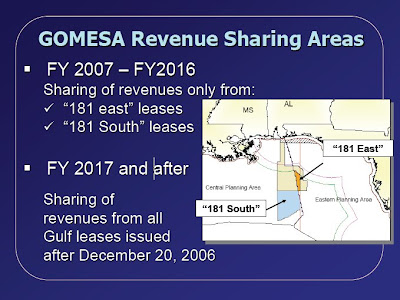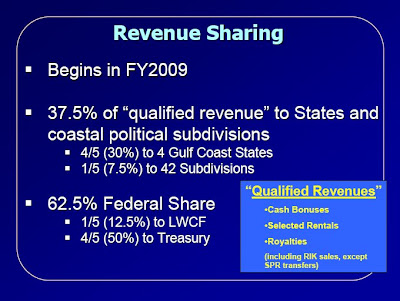Sen. Mary Landrieu called the Gulf of Mexico Energy Security Act of 2006 (GOMESA) the “fair share” bill. Not quite, if you compare it to what states get for onshore drilling on federal lands.
A slide show from the Mineral Management Service outlines how offshore revenue in the outer continental shelf (OCS) - the federally administered seas - will be shared with the Gulf Coast states under GOMESA, just as onshore drilling revenue from federally administered land is shared with the states where it is generated. I am calling “unfair” on a few points.
UNFAIR #1: Gulf Coast states will get a decreased share of OCS offshore revenue off their borders until 2017.
The government will not share money generated from all federal leases in the Gulf of Mexico until 2017 (and we still won’t get any credit for leases sold before 2008). For the next nine years, Gulf Coast states will get a share of revenue in new federal leases in just two areas: 181 East and 181 South.

Starting in 2017, we get a share of revenue from all new leases – but just new leases.
The latest lease sale in March is a good example of what we are missing until 2017:
Two federal sales of offshore oil and natural gas leases in the Eastern and Central Gulf of Mexico attracted more than $3.7 billion in high bids today…Sale 224 had leases in the 181 areas, the areas that Gulf states get a share of. And, as the press release stated, we get 37.5 percent of those leases, or around $24.2 million – split between four states.
***
The first sale, the Central Gulf of Mexico Sale 206, attracted a record-setting $3,677,688,245 in high bids. This sets the record in high bids in U.S. leasing history since area-wide leasing began in 1983.
***
For Eastern Gulf of Mexico Sale 224, MMS received 58 bids from 6 companies on 36 tracts resulting in $ 64,713,213 in high bids with an estimated 37.5 percent of that amount going directly to four Gulf producing States.
That’s a lot of money. But, if this were 2017, the Gulf Coast states would be splitting 37.5 percent of both sales, which would come out to $1.4 billion – a big difference, and one that would help us out in our attempt to pull together the required matching funds for federal flood protection projects.
UNFAIR #2: Four Gulf Coast states must share 37.5 percent of offshore revenue while onshore drilling states get (at least) 50 percent of the revenue generated on federal land in their state.
That speaks for itself. It just sucks.
Here is how the MMS divides onshore revenue from drilling on federally owned land:
Distribution of revenues associated with onshore federal lands is split 50-40-10, with 50 percent of the money going directly to the state within which the specific lease was located. Forty percent is sent to the Reclamation Fund of the U.S. Treasury. This special account finances the Bureau of Reclamation's water projects in 17 western states. The remaining 10 percent goes to the Treasury's General Fund.Emphasis mine.
One exception, Alaska, gets a 90 percent share of the revenues. The remainder goes to the U.S. Treasury.
Not only does 50 percent go to the onshore drilling states (90 percent to Alaska), but if you live in one of the 17 western states that have Bureau of Reclamation water projects, then you get a share of another 40 percent.
The Gulf Coast states, in contrast, *collectively* get 37.5 percent of offshore drilling revenues.
For each individual state, that number is even smaller than it looks – split into 30 and 7.5.

The state governments get the 30 percent, then divide it further among the four of them (Louisiana, Mississippi, Alabama, and Texas). And the oil-producing parishes and counties split up the 7.5 percent. This document shows the "42 subdivisions."
UNFAIR #3: Offshore revenue has strings attached. Onshore revenue doesn’t.
Half of onshore drilling revenue goes “directly to the state within which the specific lease was located.” According to a 2003 fact sheet, the onshore revenue can be “used as the States deem necessary, without Federal restrictions. Oftentimes the monies are used for schools, roads, public buildings, or general operations.”
Under GOMESA, offshore revenue can not be used for schools, roads, public buildings, or general operations, even if those projects are part of recovery from Hurricanes Katrina and Rita. GOMESA has federal restrictions (from the MMS slide show):
Coastal Protection
Conservation; Restoration; Hurricane Protection
Mitigation of damage to animals or natural resources
Mitigation of effects from OCS activities through onshore infrastructure projects
Associated planning and administrative costs

Now, these are excellent uses of the funds. But each onshore drilling state gets 50 percent of its revenue without restrictions. Gulf Coast states share 37.5 percent and we are told how to spend it.
On top of that, 17 western states get their non-restricted 50 percent plus a share of another 40 percent in water projects by the Bureau of Reclamation.
A similar arrangement for Gulf Coast states would be fair. Each Gulf Coast state could get 50 percent of the revenue generated from offshore drilling near its coast with no restrictions and then 40 percent could go to coastal protection projects along the Gulf.
Unfortunately, there is no Bureau of Coastal Protection for that 40 percent to go to.
UNFAIR #4: 12.5 percent of offshore drilling revenue goes to public outdoor recreation grants in the all the states and territories of the U.S. and Washington, D.C.
What?
A fifth of the federal government’s take (12.5 percent overall) of revenue generated from offshore drilling goes to the Land and Water Conservation Fund (see the revenue slide above).
In fact, according to the LWCF website, that share of offshore drilling appears to be its entire budget for 2009:
The President's budget for FY 2009 again proposed zero funding for LWCF State grants. However, for the first time in the program’s history, legislation has been enacted which insures that regular LWCF appropriations will be supplemented by proceeds from certain oil and gas leases in the Gulf of Mexico. Section 105 of the Gulf of Mexico Energy Security Act (GMESA) designates 12.5 percent of the proceeds from leases in Areas 181, 181 South and the 2002-2007 planning areas to be dispensed to the States in accordance with Section 6 of the LWCF Act.The Gulf States benefit from the LWCF. Louisiana, Mississippi, Alabama, and Texas got about $2.2 million in 2008 from the fund. Texas got more than half of that money. And I am not saying the LWCF should not be funded.
But why is 12.5 percent of offshore drilling revenue going to fund outdoor recreation all over the U.S.? The 12.5 percent that goes to the LWCF is exactly *one third* as much as the 37.5 percent of offshore revenue that the four Gulf Coast states must share. That means at least one Gulf State will receive less money from offshore drilling in the Gulf of Mexico than the Land and Water Conservation Fund will get from those revenues. That is not fair.
UNFAIR #5: Basically, 100 percent of offshore drilling revenue goes to the federal government’s interests.
-50 percent goes to the U.S. Treasury General Fund.
-12.5 percent goes to the federal Land and Water Conservation Fund.
-37.5 percent goes to protecting the coastal areas that support the infrastructure required for offshore drilling.
Add up those numbers and you get 100 percent.
Yes, Louisiana benefits from GOMESA. I am just saying we are still not getting our fair share.
Conditional UNFAIR #6: Offshore revenue available for the Gulf Coast states is capped at $375 million.
This UNFAIR is conditioned on 1) the assumption that onshore revenue is not capped for states and on 2) the assumption that I am reading the GOMESA bill correctly.
CONDITION 1) I can not find supporting information that onshore revenue is capped. If onshore revenue is not capped, then it is unfair to cap offshore revenue.
CONDITION 2)The way I read the bill as signed by the President, the money that can go to the states *and* the LWCF is capped at $500 million (look under SEC. 105).
Half the revenue generated by offshore drilling is distributed to the Gulf Coast states and the LWCF [SEC. 105 (2)(A) and (B)]. The states split 75 percent of that (37.5 percent overall) and the LWCF gets 25 percent of half (12.5 percent overall).
Under the title “Limitations on Amount of Distributed Qualified Outer Continental Shelf Revenues” [SEC. 105 (f)(1)], revenue is capped at $500 million. To me, that means the most the Gulf Coast states can get is 75 percent of $500 million, which is $375 million.
Also, the minimum revenue one of the four states can get in a year is 10 percent of the 75 percent of the 50 percent set aside to be distributed [SEC. 105 (b)(1)(B)]. So, if the cap on that 50 percent is $500 million, then three states have to get at least $37.5 million. That means the most any one state can get in one year is $262.5 million in revenue.
Once again, that's plenty of money. But the cap is unfair.
UNFAIR RECAP:
1) Gulf Coast states have a decreased share of revenue until 2017.
2) Four Gulf Coast states split a smaller percentage than each onshore drilling state gets from drilling on federal land inside its borders.
3) All offshore revenue that goes to Gulf Coast states has strings attached. Onshore revenue that goes to states doesn’t.
4) All 50 states, U.S. territories, and Washington, D.C., get funding from offshore revenue as part of the sharing agreement - besides half of the revenue that already goes into the U.S. Treasury general fund.
5) Basically, 100 percent of OCS offshore drilling revenue goes to the federal government’s interests.
6) There is a cap on how much Gulf Coast states can get. (conditional)